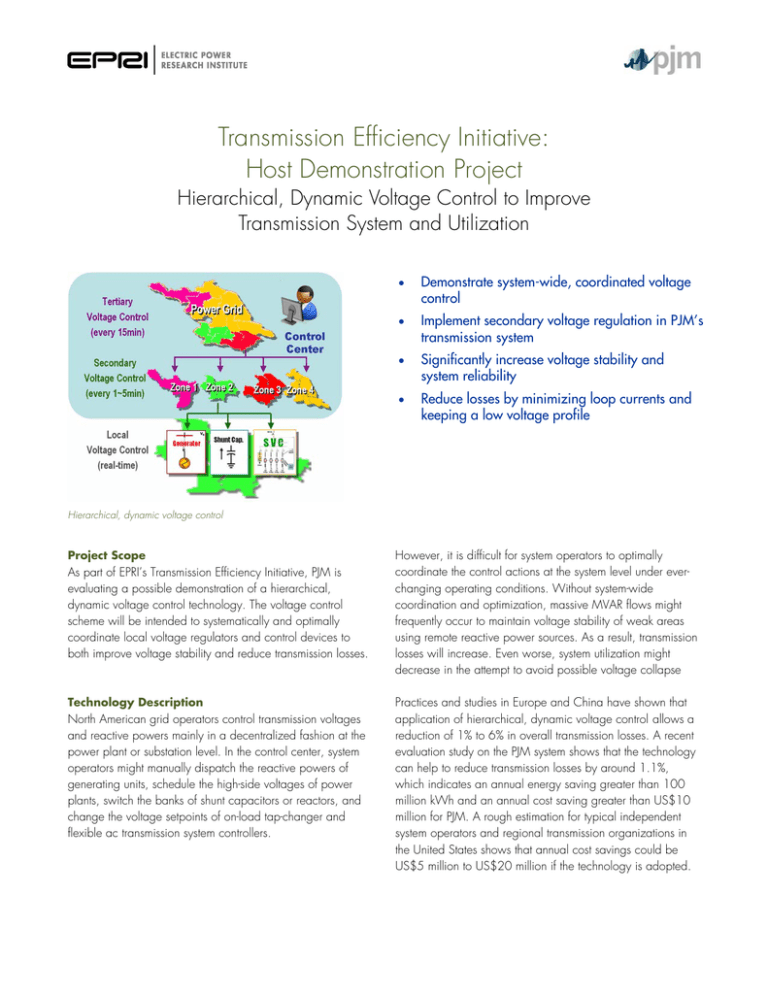
Transmission Efficiency Initiative:
Host Demonstration Project
Hierarchical, Dynamic Voltage Control to Improve
Transmission System and Utilization
•
Demonstrate system-wide, coordinated voltage
control
•
Implement secondary voltage regulation in PJM’s
transmission system
•
Significantly increase voltage stability and
system reliability
•
Reduce losses by minimizing loop currents and
keeping a low voltage profile
Hierarchical, dynamic voltage control
Project Scope
As part of EPRI’s Transmission Efficiency Initiative, PJM is
evaluating a possible demonstration of a hierarchical,
dynamic voltage control technology. The voltage control
scheme will be intended to systematically and optimally
coordinate local voltage regulators and control devices to
both improve voltage stability and reduce transmission losses.
Technology Description
North American grid operators control transmission voltages
and reactive powers mainly in a decentralized fashion at the
power plant or substation level. In the control center, system
operators might manually dispatch the reactive powers of
generating units, schedule the high-side voltages of power
plants, switch the banks of shunt capacitors or reactors, and
change the voltage setpoints of on-load tap-changer and
flexible ac transmission system controllers.
However, it is difficult for system operators to optimally
coordinate the control actions at the system level under everchanging operating conditions. Without system-wide
coordination and optimization, massive MVAR flows might
frequently occur to maintain voltage stability of weak areas
using remote reactive power sources. As a result, transmission
losses will increase. Even worse, system utilization might
decrease in the attempt to avoid possible voltage collapse
Practices and studies in Europe and China have shown that
application of hierarchical, dynamic voltage control allows a
reduction of 1% to 6% in overall transmission losses. A recent
evaluation study on the PJM system shows that the technology
can help to reduce transmission losses by around 1.1%,
which indicates an annual energy saving greater than 100
million kWh and an annual cost saving greater than US$10
million for PJM. A rough estimation for typical independent
system operators and regional transmission organizations in
the United States shows that annual cost savings could be
US$5 million to US$20 million if the technology is adopted.
A typical hierarchical, dynamic voltage control strategy
realizes system-wide coordination and optimization through
two-level voltage regulators above local voltage control
devices (local voltage control devices installed at power
plants or substations):
• Secondary (regional) voltage regulators, coordinating
setpoints of the control devices within each voltage
control zone, aimed at improving voltage quality and
reliability
• Tertiary (system-wide) voltage regulators, providing
optimal voltage references at the pilot buses located in
all voltage control zones by solving optimal reactive
power flow to minimize the overall transmission loss.
The detailed methodology of M&V will be developed during
the course of the project using the following general
approach:
• Demand, energy, and CO2 savings.
• Line load and losses will be measured and compared
over a one-year period and compared to the
calculations. This will lead to an industry-accepted
methodology for projecting savings from advanced
conductor projects.
• System utilization improvement will be assessed by
considering generation dispatch, congestion costs, and
other metrics that will be defined.
The tertiary and secondary voltage regulators can both be
installed at the grid control center or can be installed at the
grid control center and sub-grid control centers for voltage
control zones, respectively.
Project Schedule
Expected Benefits
Practices of hierarchical voltage control in Europe and China
have shown that the following benefits might be realized
through the application of hierarchical, dynamic voltage
control technology:
• Increased overall utilization of the transmission system by
improving voltage stability
• Better utilization of reactive power sources
• Reduced transmission losses
• Reduced CO2 emissions as a consequence of better
system utilization and lower losses
Approach for Measurement and Verification
A key objective of EPRI’s Transmission Efficiency Initiative is to
verify and validate the “actual” benefits realized by the
application of the technology using a consistent measurement
and verification (M&V) methodology that will be developed
as part of EPRI’s transmission efficiency research portfolio.
The expected project tasks are the following:
• EPRI will work with PJM to test and document the benefits
of a hierarchical dynamic voltage control strategy that
can meet the voltage control requirements. The interfaces
with supervisory control and data acquisition and energy
management systems as well as the operator interface
will also be assessed and defined as needed.
• EPRI will work with PJM vendors to assess the
performance of system-wide hierarchical, dynamic
voltage control strategy and associated algorithms. EPRI
will apply the demonstration and loss reduction
verification protocol developed as part of the initiative to
document the impact that changes in operations can
have on loss reduction and utilization improvements.
• PJM might also evaluate the feasibility of a closed-loop
implementation of the strategy.
• EPRI will conduct M&V to assess the benefits achieved.
The deliverables of this project will include a technical report
with the functional and interface specifications of the systemwide hierarchical, dynamic voltage control strategy, as well
as the software package for the hierarchical, dynamic voltage
control implementation.
April 2010
Electric Power Research Institute
3420 Hillview Avenue, Palo Alto, California 94304-1338 • PO Box 10412, Palo Alto, California 94303-0813 USA
800.313.3774 • 650.855.2121 • askepri@epri.com • www.epri.com
© 2010 Electric Power Research Institute (EPRI), Inc. All rights reserved. Electric Power Research Institute, EPRI, and TOGETHER…SHAPING THE FUTURE OF ELECTRICITY are registered service
marks of the Electric Power Research Institute, Inc.


